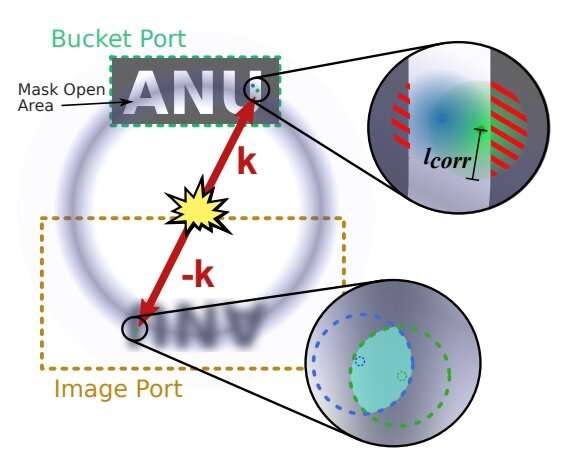June 26, 2019 feature
Quantum ghost imaging improved by using five-atom correlations

In conventional imaging methods, a beam of photons (or other particles) is reflected off the object to be imaged. After the beam travels to a detector, the information gathered there is used to create a photograph or other type of image. In an alternative imaging technique called "ghost imaging," the process works a little differently: an image is reconstructed from information that is detected from a beam that never actually interacts with the object.
The key to ghost imaging is to use two or more correlated beams of particles. While one beam interacts with the object, the second beam is detected and used to reconstruct the image, even though the second beam never interacts with the object. The only aspect of the first beam that is detected is the arrival time of each photon on a separate detector. But because the two beams are correlated, the image of the object can be fully reconstructed.
While two beams are usually used in ghost imaging, recent research has demonstrated higher-order correlations—that is, correlations among three, four, or five beams. Higher-order ghost imaging can lead to improvements in image visibility, but it comes with the drawback that higher-order correlated events have a lower probability of detection, which causes lower resolution.
In a new paper, a team of physicists from the Australian National University in Canberra has achieved two firsts in higher-order ghost imaging: the first demonstration of higher-order ghost imaging with massive particles (they use ultracold helium atoms) and the first higher-order ghost imaging that uses correlated beams from a quantum source. As their quantum source, the researchers used two colliding Bose-Einstein condensates, which are clusters of atoms cooled to near absolute zero. At such cold temperatures, the atoms in a Bose-Einstein condensate clump together and behave like a single giant atom.
In their work, the researchers performed experiments using correlations among up to five helium atoms. They demonstrated that, under certain conditions, higher-order ghost imaging with massive particles from a quantum source can improve the visibility of the image without affecting the resolution.
"I think the greatest significance of our work is mostly being able to show that such a challenging experiment is possible," physicist Sean Hodgman at Australian National University, first author of the paper, told Phys.org. "There are a very small number of multi-particle correlated events in a quantum source, which is partially why it has not been demonstrated previously with optics, and this means even after many tens of thousands of experimental runs only very few events are available to reconstruct a ghost image from."
The improvements demonstrated here could be especially beneficial for applications that demand high visibility but are easily damaged. This is because the technique has the potential to reduce the dosage rates, which reduces the potential radiation damage to the sample. One such application is atomic ghost lithography.
"Atomic ghost lithography would be like normal atom lithography, but using correlated beams would allow real-time monitoring of the lithographic process," Hodgman said. "Higher-order correlations would improve ghost lithography by allowing lower fluxes with the same signal quality, which is important as high fluxes risk damage to the sample."
With further work, higher-order quantum ghost imaging could also be used to perform fundamental tests of quantum mechanics, such as demonstrating entanglement among multiple atoms or, in a related vein, making Bell's inequality measurements using three or more particles.
More information: Sean S. Hodgman, Wei Bu, Sacha B. Mann, Roman I. Khakimov, Andrew G. Truscott. "Higher Order Quantum Ghost Imaging with Ultra-Cold Atoms." Physical Review Letters. DOI: 10.1103/PhysRevLett.122.233601
Also at arXiv:1901.06810 [cond-mat.quant-gas]
Journal information: Physical Review Letters
© 2019 Science X Network


















